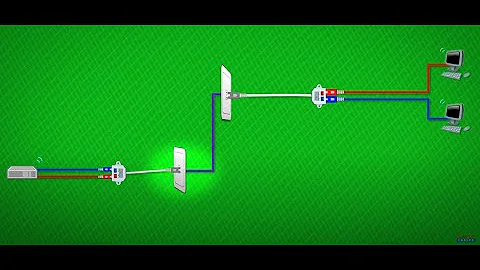How to securely run two LANs on a single ethernet cable?
Solution 1
It will need two things:
- Switches that support VLANs and VLAN trunking.
- The router must have more than one ethernet port.
You have to create two VLANs and one Trunk on each switch :
Room B:
VLAN A - Ports that connect internal users
VLAN B - Port to Wireless access point
Trunk - Port to the only ethernet cable going to Room A
Room A:
VLAN A - Ports that connect file, server, firewall and router
VLAN B - Port that connect to second ethernet port on router
Trunk - Port to the ethernet cable coming from Room B
In this way, both VLANs share the ethernet cable through the Trunk.
The second port on the router must be on the 10.59.0.1/24 network and there should be only one route pointing outside, to avoid that guests can go to the internal network.

Solution 2
A cheaper way would be use the existing cable since Fast Ethernet (100Mbit) only uses pins 1,2,3,6. You can therefore run 2 fast Ethernet connections (100Mbit) over a Cat5 if you utilize the unused 4,5,7,8 pins. Note though that Gigabit Ethernet requires 4 pairs.
A final point is that if your router has Gigabit ports and you connect an Ethernet cable with only 1,2,3,6 pins connected your router will automatically connect in 100Mbit so the following will still work.
You will need to make your own Ethernet cable so you should be comfortable in crimping. You will also need a basic Ethernet cable tester.
I am using TIA-568b convention below (https://en.wikipedia.org/wiki/TIA/EIA-568)
Custom cable LAN1 JACK ETHERNET CABLE PIN PIN 1--------------->1 orange/white 2--------------->2 orange 3--------------->3 green/white 6--------------->6 green
LAN2 JACK ETHERNET CABLE PIN PIN 1--------------->4 blue 2--------------->5 blue/white 3--------------->7 brown/white 6--------------->8 brown
Enjoy
Solution 3
I was faced with the same dilemma and decided running multiple Ethernet cables was cheaper than the expensive switches.
Related videos on Youtube
kar.bon
var job = ((lang=='js') ? 'Web' : 'Delphi') + 'Developer';
Updated on September 18, 2022Comments
-
kar.bon over 1 year
there are two rooms (A and B) connected by an ethernet cable (~50 meters long). All the main appliances are in Room A (router, server, firewall, smart switch…). Currently all the devices in both the rooms works on the Private LAN with subnet 192.168.0.1/24.
I need to add a WLAN for guests on the Room B with subnet 10.59.0.1/24 which has to be separated from the Private LAN.
Given the fact that the electrician says it is nearly impossible to run another cable between the two room
What is the best way to do it?P.S.
- I already tried with two cheap Y Ethernet splitter without luck (and however this would reduce a lot the bandwidth)Thanks
-
 Admin almost 9 yearsWhich services the Room B users need to connec to?
Admin almost 9 yearsWhich services the Room B users need to connec to? -
 Admin almost 9 yearsIn the Room B the users on the private subnet needs to access the file server (so more bandwidth means more happiness). The guests only needs to connect to Internet (max 20 Mbps).
Admin almost 9 yearsIn the Room B the users on the private subnet needs to access the file server (so more bandwidth means more happiness). The guests only needs to connect to Internet (max 20 Mbps).
-
-
kar.bon almost 9 yearsThank you @jcbermu for your great answer! Could there be problems if the switcher are not of the same manufacturer?
-
 jcbermu almost 9 years@Carlo Boninsegna There is an standard protocol for VLAN support called
jcbermu almost 9 years@Carlo Boninsegna There is an standard protocol for VLAN support calledIEEE 802.1Q. Verify that both switches are 802.1Q compliant, and if they are you shouldn't have any problem. -
 Ravindra Bawane over 7 yearsThat might work, but that's very hacky, and with a business network you really should be running VLANs anyways for isolating this sort of traffic.
Ravindra Bawane over 7 yearsThat might work, but that's very hacky, and with a business network you really should be running VLANs anyways for isolating this sort of traffic. -
Jochen Lutz over 6 yearsIf the router supports VLAN, you could connect it to a trunk port and have only one connection between the router and the switch. Most routers with a integrated switch do support 802.1Q -- at least the hardware. Most consumer router's firmwares don't offer a interface to configure VLAN.





